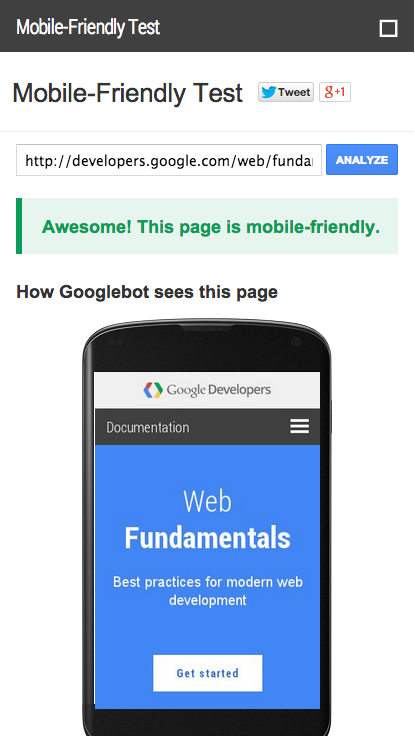In the spring of 2015, Google released an update to their algorithm that favored websites with mobile versions over websites without mobile versions. Why would Google do such a thing? Because over half of all internet searchers are now being conducted on mobile devices and Google’s entire goal is to present their searchers with the most relevant webpages—that means webpages that can be viewed on their mobile devices.
While Google will give a penalty to websites without mobile versions, it does not mean that your website has been removed from the search results entirely. It just means that you are going to drop down below websites that do have mobile optimization. Because your position in the search results is strongly correlated with how successful you are, it’s important to make sure that your website adheres to Google’s mobile update. Here’s how to make sure your website is properly optimized for mobile:

1. Take Google’s test
Google has set up a test to determine just how mobile-friendly websites are. They have their own tool that reviews your website and tells you exactly what you need to do in order to make your website more attractive to Google’s mobile update. Hopefully, you have a responsive website design, but if you have a separate mobile website, be sure to test it, as well as your desktop website, with Google’s Mobile Friendly Test.
2. Make sure your animated videos use HTML5.
Using videos on your webpage is a great way to engage with your site visitors, but only if those videos can actually be viewed on mobile. The HTML5 standards are the best way to make sure that your visual content meets the needs not just of the desktop browser, but also the mobile searcher.
3. Transcribe your videos.
Video transcriptions are not just ideal for those that can’t watch the video on their mobile device; they also help Google’s web crawler to determine what that video is about and to properly categorize it. Because Google always gives preference to visual media over text, having a video can only benefit your site, and having the transcript of the video can show Google the value of that video.
4. Make sure your website is not actively repelling Google’s crawlers
Unless you are familiar with web development, this is a job best left to a developer. Your developer will be able to take a look at your robots.txt file to make sure there are no robots that are preventing Google from properly crawling your website. That may sound like a nonsensical sentence to those unfamiliar with robots as they relate to Google’s algorithm, but your developer will understand what it means.

5. Eliminate bad redirects.
This is one of the most common problems that mobile-optimized websites have. The links on the mobile version connect to the wrong page, making it impossible for mobile users to navigate your website. It’s as bad for Google as it is for your site visitors, as it can get the crawler stuck in a loop of simply being redirected back to the homepage. It presents the wrong information, which is never something you want to do.
6. Make sure your load speed is on point.
Mobile searchers are just as concerned about page load speed as desktop searchers are. While they are a little more lenient, realizing that WiFi on a smartphone is almost always going to be slower than on a high-powered computer, if the page is loading slowly or incorrectly, they are still more likely to hit the back button and find a different website, rather than to wait around for yours to load. Make sure your website is not cluttered with code or media that is slowing it down.
7. Make sure your design is responsive.
Some websites can be easily navigated on mobile devices, even if they are not responsive. It doesn’t matter—Google is looking for websites that are mobile responsive. This means that your website will be easy to navigate no matter the size of the screen trying to access it. This information is much easier for Google to understand and you never have to worry about a potential customer being directed to the wrong website while they are browsing via mobile device.
Google’s mobile update doesn’t have to be a death sentence. In fact, it absolutely should not be a death sentence. Make sure that your website follows these seven simple rules and you can quickly recover from any penalty that might have been hanging over your website during the months since the update was released.
If you’re trying to recover from Google’s recent update, and need to improve your search rankings, contact our team of experienced internet marketers today. Cheers!
In the spring of 2015, Google released an update to their algorithm that favored websites with mobile versions over websites without mobile versions. Why would Google do such a thing? Because over half of all internet searchers are now being conducted on mobile devices and Google’s entire goal is to present their searchers with the most relevant webpages—that means webpages that can be viewed on their mobile devices.
While Google will give a penalty to websites without mobile versions, it does not mean that your website has been removed from the search results entirely. It just means that you are going to drop down below websites that do have mobile optimization. Because your position in the search results is strongly correlated with how successful you are, it’s important to make sure that your website adheres to Google’s mobile update. Here’s how to make sure your website is properly optimized for mobile:

1. Take Google’s test
Google has set up a test to determine just how mobile-friendly websites are. They have their own tool that reviews your website and tells you exactly what you need to do in order to make your website more attractive to Google’s mobile update. Hopefully, you have a responsive website design, but if you have a separate mobile website, be sure to test it, as well as your desktop website, with Google’s Mobile Friendly Test.
2. Make sure your animated videos use HTML5.
Using videos on your webpage is a great way to engage with your site visitors, but only if those videos can actually be viewed on mobile. The HTML5 standards are the best way to make sure that your visual content meets the needs not just of the desktop browser, but also the mobile searcher.
3. Transcribe your videos.
Video transcriptions are not just ideal for those that can’t watch the video on their mobile device; they also help Google’s web crawler to determine what that video is about and to properly categorize it. Because Google always gives preference to visual media over text, having a video can only benefit your site, and having the transcript of the video can show Google the value of that video.
4. Make sure your website is not actively repelling Google’s crawlers
Unless you are familiar with web development, this is a job best left to a developer. Your developer will be able to take a look at your robots.txt file to make sure there are no robots that are preventing Google from properly crawling your website. That may sound like a nonsensical sentence to those unfamiliar with robots as they relate to Google’s algorithm, but your developer will understand what it means.

5. Eliminate bad redirects.
This is one of the most common problems that mobile-optimized websites have. The links on the mobile version connect to the wrong page, making it impossible for mobile users to navigate your website. It’s as bad for Google as it is for your site visitors, as it can get the crawler stuck in a loop of simply being redirected back to the homepage. It presents the wrong information, which is never something you want to do.
6. Make sure your load speed is on point.
Mobile searchers are just as concerned about page load speed as desktop searchers are. While they are a little more lenient, realizing that WiFi on a smartphone is almost always going to be slower than on a high-powered computer, if the page is loading slowly or incorrectly, they are still more likely to hit the back button and find a different website, rather than to wait around for yours to load. Make sure your website is not cluttered with code or media that is slowing it down.
7. Make sure your design is responsive.
Some websites can be easily navigated on mobile devices, even if they are not responsive. It doesn’t matter—Google is looking for websites that are mobile responsive. This means that your website will be easy to navigate no matter the size of the screen trying to access it. This information is much easier for Google to understand and you never have to worry about a potential customer being directed to the wrong website while they are browsing via mobile device.
Google’s mobile update doesn’t have to be a death sentence. In fact, it absolutely should not be a death sentence. Make sure that your website follows these seven simple rules and you can quickly recover from any penalty that might have been hanging over your website during the months since the update was released.
If you’re trying to recover from Google’s recent update, and need to improve your search rankings, contact our team of experienced internet marketers today. Cheers!

